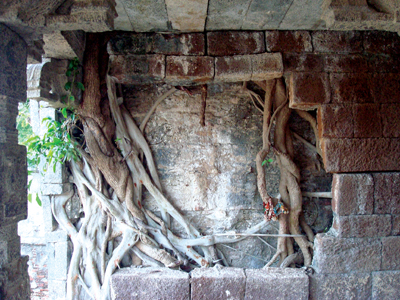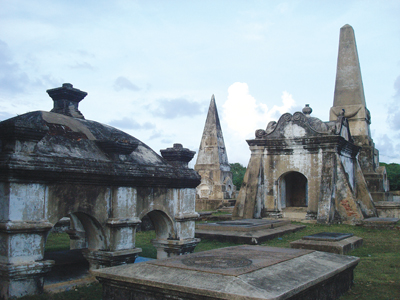Will it ever happen?
One recent lazy Sunday afternoon, a couple of friends and I took off on a drive to Pulicat (Pazhaverkadu in Tamil), to explore the sights of a fishing hamlet that was once home to the Dutch East India Company.
At the end of a 2-hour, and a fairly comfortable, drive on NH-5, we reached Pulicat. We had established contact with a local there to take us around and he was on hand to receive us.

 The Adinarayana Perumal temple of the Vijayanagara period and the roots of a tree tearing its walls open.
The Adinarayana Perumal temple of the Vijayanagara period and the roots of a tree tearing its walls open.
|
Our first stop was at an exquisite temple dating to the Vijayanagara period dedicated to Adinarayana Perumal. A locked wicket gate welcomed us. Awed by the sight of the main entrance to the temple, we were disappointed that we would be denied the opportunity to witness what lay beyond. We decided to ask around to see if someone could guide us to the person who would have the keys to the temple and so, off went one of my friends and the local contact. They returned 10 minutes later with the good tidings that the priest was on his way and, sure enough, he appeared not long after. The priest unlocked the main entrance and a huge temple greeted us.
Though a magnificent temple, it was in complete ruins. Huge roots had literally torn it apart at various places. After returning from the visit, a little research on the internet revealed that the entire construction was of laterite stone, a material seen used in Kerala palaces and commonly seen in Malabar and the Konkan coast, but not seen in Tamil Nadu. So it was the type of construction that made this temple unique.
The area leading to the sanctum sanctorum was surprisingly neat and well maintained. The priest explained to us that it had been spruced up when some basic work had been undertaken in 2009 and 2010. He also mentioned that there was talk of HR & CE aid forthcoming but that nothing had come out of it so far. We could gather from him that a feud between Pazhaverkadu and another village, the name of which we couldn’t catch, had led to this temple being neglected. We could not even complete the circumambulation as the path was full of thorns.

The Dutch Cemetery at Pulicat
|
After leaving the temple, our next stop was the Dutch cemetery. Pulicat was the principal trading post of the Dutch East India Company, whose factory was established there in 1610. Legend has it that they first established contact with the local Muslim traders and that it was they who helped the Dutch get a trading grant from Queen Obayama, the wife of King Venkata II, the Vijayanagara ruler. It was from Pulicat that the Dutch successfully carried out much of their trading operations for the next 200 years, before surrendering the settlement to the British East India Company in 1825.
All that remains today signifying that it was once a Dutch enclave is the cemetery. Fort Geldria, the fort built by the Dutch around 1615 as a means of protection, had been demolished, first by Hyder Ali and later by the British when they took control of Pulicat.
Maintained by the ASI, the cemetery was open, but there was not a soul in sight. Once we entered, it was so quiet that it was hard to believe that we were just a minute away from the main market of Pazhaverkadu! Two beautifully sculpted skeletons greeted us at the entrance. Inside the cemetery were well maintained graves of various Dutch residents and officials of Pulicat. We could also see a couple of English tombstones in a far corner, obviously sited after 1825.
Coming out of the cemetery, we made brief stops at a couple of old churches. The older of them, called the Our Lady of Glory Church (said to date to the Portuguese period), had been demolished and was being reconstructed. The other church, a small, beautiful one called the St. Anthony’s Church, was closed and we could only get a glimpse of it from the outside. We then drove over the bridge across the lake connecting one side of this fishing hamlet to the other. This bridge, which has been recently opened, has improved connectivity with the mainland for the many villages on the other side of the lake. It was twilight and the lake presented a pretty sight in the fading light.
Our last stop for the evening before we drove back was to catch up with a bit of Muslim history. Pulicat has a long association with the Muslim community, with Arabian traders settling there nearly 800 years ago. Two prominent mosques, both nearly 300 years old, are the main places of worship. The smaller of the two mosques, the Chinna Pallivasal, has an interesting feature, a sundial that was installed in 1914 to show the time based on which the people would assemble for prayer. A Madrasa also functions in the vicinity, where the children receive Islamic instructions. The Arwi language, a blend of Tamil and Arabic, is another interesting feature of the place. Dating to the time the Arabs first settled in Pulicat, this language today has very few takers amongst the Muslims of Pulicat, with only a handful of people amongst the local population having a knowledge of it. Essentially Tamil written in Arabic, the script has certain special symbols as Tamil has more consonants and vowels than Arabic. Arwi was used during the freedom struggle as a means of secret communication, as the British translators could understand only the Arabic script.
It was soon time for us to make the two-hour drive back to the city. We were left ruing the fact that we had mistimed our trip, as the three hours we had in Pulicat offered only a glimpse of the local culture and nothing more. We had also missed out on visiting the Pulicat Lake Bird Sanctuary.
With so much of rich history in Pulicat, not to mention the placid waters of the lake and the beach beyond, it is a place that offers an opportunity to be developed as an exciting tourist destination. Though tourists do visit the place for joy rides on the lake and enjoy the bird sanctuary, its potential needs to be harnessed much more.
|